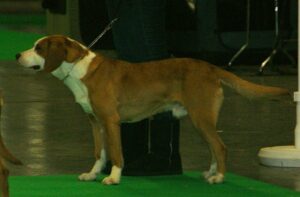The Alpine Dachsbracke is a scenthound used for tracking wounded deer and hunting both hare and fox. He was at one point in history owned by German royalty. This Austrian breed dates back to the mid-19th century and was recognized in 1932 in Austria, and by the FCI in 1991. He is considered a rare breed in the United States, where he is recognized only by the UKC. Despite his small size, this is a hardy breed able to work in tough terrain and in high altitudes when necessary.
Alpines are super friendly to family/friends/strangers alike although are also quite brave and ready to “give it their all” when it comes to hunting! Because of their strong instincts they are often found in hunting homes rather than companion homes, although this is not to say that they can’t make great family dogs. Usually able to get along great with other dogs and children; their biggest fault is the same as other hunting scenthound breeds – high prey drive. For instance they aren’t as good with smaller pets and can be cat-chasers if not raised with them from puppyhood. They do best with owners who understand the quirks of living with scenthounds. For those who can meet their particular needs, however, these are loyal and loving hounds with level-headed attitudes.
The Alpine Dachsbracke is easy to housebreak, intelligent and trainable although can also be easily distracted by interesting scents. He wasn’t bred to follow commands, he was bred to sniff out game. Like many scenthounds, off-lead training requires more work on the part of the owner/trainer. Making training sessions interesting and short will be more beneficial for this breed than long, drawn-out sessions. Although he doesn’t need as much mental stimulation as some breeds, he definitely needs his fair share of “brain games” to be happy. Obedience training can be one great way to stimulate that brain! Without some kind of mental exercise he can become stubborn, destructive and a general pain to live with. 
It is clear to see the Dachshund lineage in the Alpine. He retains the long, low body and short legs that his ancestor also possesses although his legs aren’t quite as stubby. Although short in stature (14-15 inches at the withers), he is quite robust and weighs much more than similar dogs of his height (up to 40 pounds). The coat is short although thick and dense, with a double coat that makes him fully capable of living in cold temperatures. The preferred color of the breed is a distinctive “dark deer red” which may or may not include interspersed black hairs. The other acceptable color is black and tan with the traditional markings of other black/tan breeds (including the Dachshund).
The average lifespan of the Alpine Dachsbracke is about 12 years. While generally healthy, like other dwarf breeds he can have back issues. Keeping him fit and not letting him jump off of high furniture can help keep extra stress off his back and avoid injury. Regular exercise is also important to maintain a healthy spine. This is a very active dog that requires a fair amount of exercise! If he were larger he would likely need an extreme amount, although his short legs make the exercise requirement easier to maintain. Thirty minutes a day should be considered a good minimum to meet, in addition to free romping time in a (fenced) yard. This is not a good choice for apartments unless the owner is able to provide extremely substantial exercise every day.
Most Alpines make great watchdogs although they aren’t known as guard dogs. Not really aggressive nor intimidating in terms of size, they’ll bark but probably won’t do much beyond that. They are alert and interested in the world around them, and enjoy watching out the windows to see what’s going on! When their owners leave, most aren’t known for having separation anxiety issues for although they do love and appreciate having their owners around, they also can be independent.



